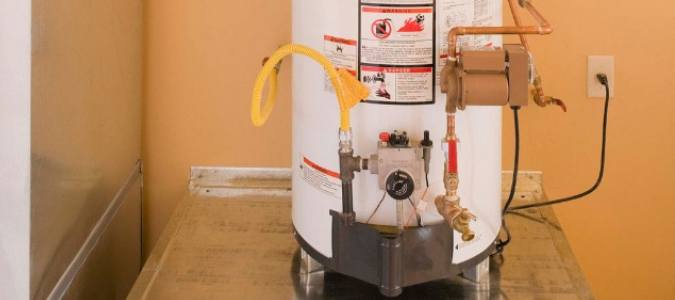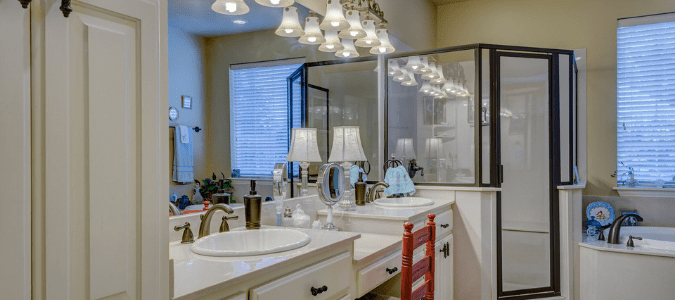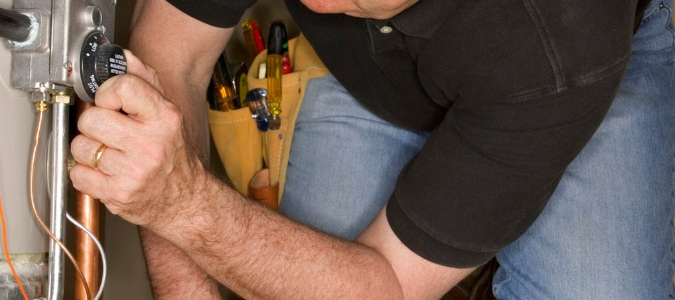There is no better way to end a long day than hopping in the shower and letting the hot water relax you. But that peace will quickly go away if your water heater is making a knocking noise. That is a sign of a problem that you should not ignore. If you’re experiencing this issue, here are some possible explanations and what you should do about it.
What Does It Mean When Your Water Heater Is Making a Knocking Noise?
The most common culprit behind a water heater that makes a knocking noise is residue buildup. Minerals and particles like calcium can find their way inside your water heater and accumulate over time. Aluminum anode rods inside the water heater, plus high pH levels, can also produce gel-like sediment.
The residue buildup traps water at the bottom of the tank near the heating element. As the water heats up, it will bubble up and try to escape the layer of sediment. It will create a knocking or popping sound as it forces its way through. Your water heater may sound like a percolating coffee maker.
You might hear the same noise if there is a layer of sediment around the heating element. It will cause the heating element to work harder than it typically does to heat the same volume of water, producing a knocking sound.
How To Prevent Sediment Buildup in Your Water Heater
Sediment buildup won’t make your water heater explode. But it can cause your water heater’s tank to overheat and deteriorate. Eventually, your water heater could leak or burst and cause significant damage to your home. Here are some ways to prevent sediment buildup and keep your water heater running smoothly for years.
Flush Your Water Heater
Make it a habit to have your water heater flushed twice yearly to prevent residue buildup. Many homeowners opt to have a professional who knows how to flush a water heater do this task. They start by turning off the water heater. Then, they shut off the cold water supply to prevent more water from flowing into the tank and wait for the water to cool. Finally, they will open a hot water tap nearby and let it run throughout the flushing process so there is no vacuum.
To start flushing, they then attach a hose to the drainage valve. Then, they lead the end of the hose to an area that can take scalding hot water. Professionals will let it run until the water is clear and sediment-free.
Vinegar Soak
You can do a vinegar soak after flushing out your water heater if you want it to be extra clean. Vinegar is an effective cleaning agent in the kitchen, and it can do wonders for your water heater, too. It can help break up residue buildup and remove hard water stains.
After draining your water heater, close the drain valve and fill the tank with a gallon of cider vinegar. You can leave it in for around six hours to let it do its job. To finish, open the drainage valve, drain the vinegar and turn the power supply back on.
Install a Water Softening System
Water softener systems eliminate minerals like magnesium, calcium and iron from your water source before they can enter your home. Installing a water-softening system is a great long-term solution for preventing residue buildup.
Professional Maintenance
It is time to contact a professional plumber if none of these preventative measures work for you. Flushing your water heater can be time-consuming and labor-intensive, but they have the tools and expertise to do it properly. They know how to remove the sediment buildup and have your water heater working efficiently again without the knocking sound.
How To Drain a Water Heater
Regardless of what type of tank your water heater has, it is wise to drain it twice yearly. Just because the water that comes out is clear doesn’t mean there’s no residue buildup hiding in the tank. Eventually, it will compromise your unit’s energy efficiency and lead to more severe and costly problems. Here’s how you can safely drain your water heater. Keep in mind this task is best left to handy homeowners. Contacting a professional is the best way to have your water heater drained.
Safety First
Draining your water heater involves dealing with burning hot water. To make it a safer process for yourself, turn off the water heater several hours before draining to allow the water to cool. But if you can’t do that, the next best option is to protect your hands with thick rubber gloves. You can also wear safety goggles if you want to be extra cautious.
Quick Flush
Before draining your water heater, it can help to perform a quick flush. You can do this by opening the drain valve for a few seconds and shutting it off. That will release any stuck sediments in the valve and allow for faster drainage. You can repeat this a few times if you see many particles on your first try. Make sure the water is flowing into a bucket or an outside area.
Switch 0ff the Water Heater
Cut off the gas or power to your water heater. Next, shut off the water by turning the valve on the cold water pipe or cutting your home’s main supply. Confirm it is off by testing the hot water faucets in your house. Water may burst out initially but should stop if you shut off the water supply correctly. Leave one of the taps on throughout the draining process to alleviate pressure and facilitate better water flow.
Open the Drain Valve
Attach a hose to the drain valve and open it. While it is possible to do this with your hands, you might need a flat-head screwdriver. Once you twist the drain valve, water will immediately flow out, so ensure the hose leads to a suitable area. If using a bucket, close the drain valve periodically and dump the water before it gets full. Repeat this until the water becomes clear.
Turn on the Water Supply and Power
Close the drain valve and detach the hose. Ensure one of the hot water taps in your home is still on. You can now open the valve partially to reintroduce water into the system. Once you’ve re-energized the system, you can open the valve entirely. Go back to the hot water tap you left running and monitor it. You can turn it off when only water is coming out of it. The last step is to turn on the gas or power to the water heater. You should have hot water in your home again in an hour or so.
Contact the Professionals
While it is possible to drain your water heater yourself, it can get complicated. That is especially true if you don’t know where to locate various parts. In addition, it can be dangerous because there is hot water involved. If you don’t want the added stress, contact a professional plumber. They can easily do the job for you and even fix other issues if you notice your water heater is not working. You can also schedule regular maintenance checkups to keep your unit in excellent shape.
How To Reset a Water Heater
All electric water heaters have a reset button as a safety precaution. It trips and turns off the water heater when the temperature is too high, protecting users from getting scalded. It is similar to how circuit breakers on appliances work.
You can find your water heater’s reset button above the heating element. It is usually red. If it trips, you can reset it yourself by following these steps:
- Locate the water heater’s designated circuit breaker and turn it off. If you are unsure which one it is, turn all the circuit breakers off.
- After cutting off the power supply, go to your water heater and find its reset button. It should be the only button on the heater.
- Press the reset button and release it. You know you have successfully reset your water heater if you hear a click.
- Go back to the circuit breaker panel and turn the power back on. It may take some time for the hot water in your home to come back. It will depend on how long the water heater was off. You can give it an hour or so.
- Turn on the faucet or shower to monitor the water temperature. Check that the water is consistently hot but doesn’t overheat.
Turn to the Pros for Your Water Heater Issues
If your water heater is making a knocking noise, you can address the issue yourself. But it requires technical skills and can be dangerous if you are not careful. If you don’t have the tools or know-how, it is best to let a professional plumber handle your water heater woes. The plumber will come to your home, assess the situation and perform the necessary repairs or replacements.
ABC Can Help With All Your Water Heater Service Needs
Water heater problems can cause large disruptions in your day-to-day life. If you’re experiencing issues, contact ABC Home & Commercial Services. Our licensed professionals will fix any water heater issues you may be having.



